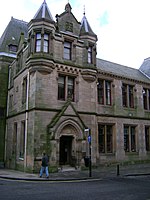Dunfermline Guildhall
1863 establishments in ScotlandBuildings and structures in DunfermlineCategory B listed buildings in FifeCourt buildings in ScotlandGovernment buildings completed in 1863 ... and 2 more
Listed government buildings in ScotlandUse British English from September 2024

The Guildhall, also known as The Guildhall & Linen Hall, is a historic building on the High Street in Dunfermline in Scotland. The structure, which currently operates as a public house, is a Category A listed building.
Excerpt from the Wikipedia article Dunfermline Guildhall (License: CC BY-SA 3.0, Authors, Images).Dunfermline Guildhall
High Street, Dunfermline Central Dunfermline
Geographical coordinates (GPS) Address Website Nearby Places Show on map
Geographical coordinates (GPS)
| Latitude | Longitude |
|---|---|
| N 56.0712 ° | E -3.4614 ° |
Address
The Guildhall & Linen Exchange
High Street 79–83
KY12 7DR Dunfermline, Central Dunfermline
Scotland, United Kingdom
Open on Google Maps










